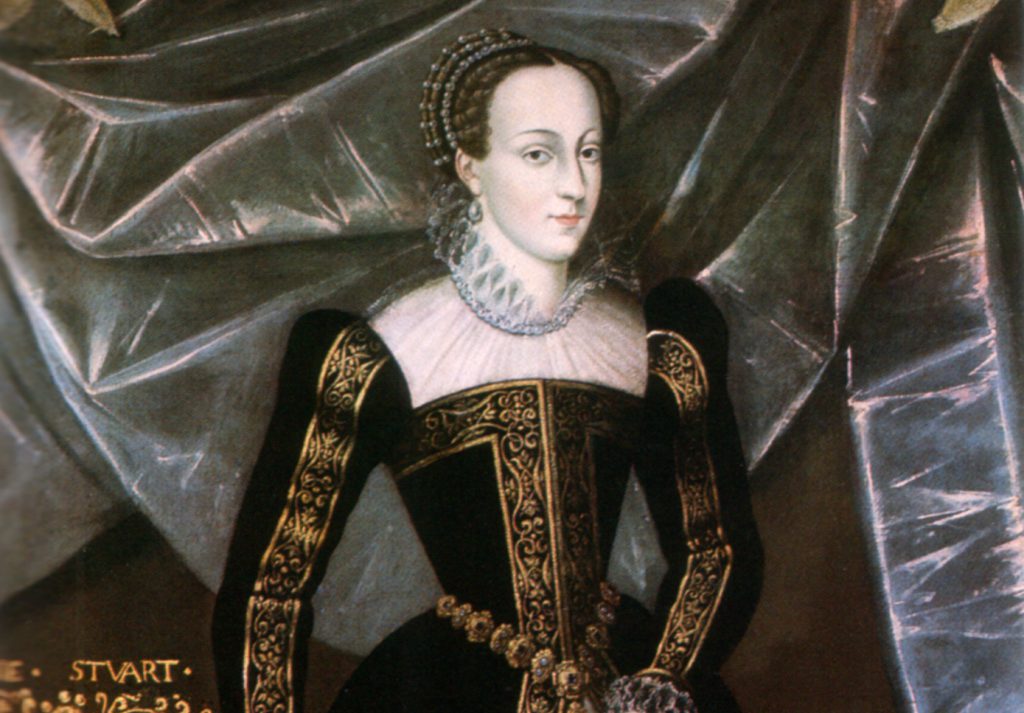Have you ever wanted something so bad you would do anything to get it? What if that goal was a crown and a whole kingdom? What would you do? Would your actions be worth it in the end if you did something that could potentially ruin your life, or even end it? Sometimes our ambitions make us act recklessly in order to achieve our goal. And in the end the results could be disastrous. As the song from the Rolling Stones says, “you can’t always get what you want,” and that is what Mary Stuart, Queen of Scotland learned the hard way when she fought for the English throne, and in the end, lost her life.
Mary Stuart was born on December 7, 1542 to King James V of Scotland and Mary of Guise1 She was the only living child of King James V, so she became the heir to the throne, and then Queen shortly after her birth, when her father died. As the granddaughter of Margaret Tudor, sister to Henry Tudor VIII King of England, she was next in line for the English throne. Because of her ties to the throne of England, she was often pushed to become the Queen of both Scotland and England.
In her attempt to become the next heir to the English throne after her cousin Elizabeth, Mary decided to wed someone who would strengthen her claim to the throne. This was a danger to Queen Elizabeth’s reign, because the people Mary considered to be a potential husband made Mary’s claim even stronger, because she would then have a husband, where Elizabeth did not. In order to gain Queen Elizabeth’s favor, Mary had considered marrying someone that Elizabeth chose for her, but when Elizabeth suggested Lord Dudley for her, the favored Earl of Leicester, Mary decided against it. Instead, she married her cousin, Henry Stuart, or Lord Darnley, who also had a claim to the English throne through his grandmother Margaret Tudor.2
This led to a rebellion in Scotland because Protestants believed that the marriage of Mary to Lord Darnley would bring Catholicism back to Scotland and England because their claim to the English throne was stronger. The rebellion was led by Mary’s half-brother James Stuart, but was defeated by Mary. This was the start of her growing unpopularity in Scotland.3 When she first met Lord Darnley, she had thought that he was charming, and quickly arranged for their marriage. But after they married, she found that his attitude was completely different. Her marriage quickly became unhappy. Lord Darnley was a drunkard and was a jealous, stubborn, immature man. Because of his immaturity, Queen Mary refused to give him the crown matrimonial, which would have allowed him to rule Scotland, and this angered him.
Mary started avoiding him, and eventually she started spending a great amount of time with some of her advisers and secretaries, particularly David Riccio. Riccio was her secretary for French correspondence, and he quickly gained influence with the Queen and her policies.4 The amount of time Queen Mary spent with Riccio created rumors that she was having an affair with the secretary and that the baby she was carrying belong to Riccio. A group confronted Lord Darnley and put this rumor in his ear. This, combined with jealousy, infuriated Lord Darnley, who created a plot to kill Riccio. In 1566, Lord Darnley, along with the group, surprised the Queen, Riccio, and a countess at dinner, and dragged Riccio out of the room and stabbed him repeatedly, killing him.5 It is also argued that Mary also could have been a target, but there is no clear evidence.
After this event Mary never forgave Lord Darnley, and their relationship became even more strained. Their son, James, who would become James I of England, was born in June 1566, and his birth did nothing to improve their relationship.6 Mary made sure that Lord Darnley would never forget what he had done, by making comments such as the ones she made when their son was born: “My Lord, God has given you and me a son, begotten by none but you. Here I protest to God as I shall answer to him… that this is your son and no other man’s son.”7 Mary would continue to push Lord Darnley away and would completely leave him out of meetings. She decided that his presence was no longer needed, and she began looking for a way to annul their marriage. Out of fear for her son’s claim to the throne, Mary was hesitant to get an annulment.

In the meantime, the Queen met and befriended another councilor, James Hepburn, the Lord Bothwell. It was also believed that the Queen was having an affair with Lord Bothwell. On February 10, 1567, Lord Darnley was killed.8 It appeared that Lord Darnley was killed when the house he was staying at had exploded, but it was later discovered that he was killed somewhere else entirely and by suffocation. Automatically, the suspicion fell on Lord Bothwell, and it is speculated that Mary also had a role in the murder.9 There is evidence that could possibly connect Mary to helping Lord Bothwell plot the death of her husband, known as the Casket Letters, but there is still not enough evidence. To this day it is still unknown whether the Queen of Scotland had a role in Lord Darnley’s murder. The rumors of an affair between Queen Mary and Lord Bothwell became stronger when she refused to convict Lord Bothwell, and he was subsequently acquitted of all charges, despite the advice of Queen Elizabeth and her former mother-in-law, Catherine Medici of France.10
Shortly after, Mary and Lord Bothwell married, which to many only confirmed the rumors. Mary claimed that Lord Bothwell abducted, raped, and forced her into the marriage.11 Like her last marriage, she was not happy. She appeared to regret marrying Lord Bothwell and seemed depressed, listless, and would often talk of suicide. Her marriage was the last straw for what little supporters she had left, and a civil war broke out in Scotland. By June, the Earl of Moray had an army to fight Queen Mary and Lord Bothwell under the banner of the murdered Lord Darnley and their son James.12 The rebels believed that Mary was no longer fit to rule because of the marriage. When she was captured at Carberry Hill, she was given the choice to keep the throne if she gave up Lord Bothwell. When she refused the offer, even her own army began to desert her. Lord Bothwell was able to escape, but the Queen was captured and taken prisoner to Edinburgh.13 On July 24, Mary was forced to abdicate the throne to her son James, and his regency would be given to the Earl of Moray.
Mary escaped Scotland to England shortly after, and begged her cousin, Queen Elizabeth, for sanctuary. Queen Elizabeth’s advisers warned her against it, because they thought she was a threat, but Queen Elizabeth allowed her to stay. While in England, Mary was under investigation again for the murder of her husband Lord Darnley, and due to the lack of evidence, she was not convicted. While in England, she was kept almost like a prisoner, under house arrest for the next eighteen years, without being able to contact her son, the now King of Scotland.14 She would spend most of her time knitting, but that was not all she was doing.

Some of Queen Elizabeth’s advisers had been keeping an eye on Mary, and they discovered three plots against Queen Elizabeth that would seal Mary’s fate. The first plot, known as the Ridolfi plot, was a conspiracy with Thomas Howard and King Philip of Spain, to assassinate Queen Elizabeth and make Mary Queen of England.15 Letters discussing the plot were intercepted by one of Queen Elizabeth’s advisers and the plot was foiled. The Queen’s advisers pushed her to punish Mary, but she refused because the evidence was not certain. In the end, Howard was executed and Mary remained a prisoner. The second plot was called the Throckmorton plot. In this the French were to invade England and assassinate Queen Elizabeth. From this, Parliament created an act for the Queen’s safety. In this act, if the Queen was killed, any party responsible would be tried and executed.16 In the final plot, Mary was caught in the act by an undercover agent who found the letters that incriminated Mary Stuart. Queen Elizabeth’s advisers strongly pushed for her to sign Mary’s death warrant, but she hesitated because she did not want the controversy of executing a queen. In the end, she reluctantly signed the warrant and on February 8, 1587, Mary was beheaded without the Queen’s knowledge.17
From the beginning, Mary Stuart had wanted the English throne and she made decisions that she thought would make her a better candidate for that throne. She thought the best way to gain the crown was through marriage, but in the end you could argue that that was the beginning of her downfall. You could say she most certainly did not get what she wanted.

- Elizabethan World Reference Library, 2007, s.v. “Stuart, Mary.” ↵
- Elizabethan World Reference Library, 2007, s.v. “Stuart, Mary. ↵
- Elizabethan World Reference Library, 2007, s.v. “Stuart, Mary.” ↵
- Women in World History: A Biographical Encyclopedia, 2002, s.v. “Mary Stuart (1542-1587),” by Kimberly Estep Spangler. ↵
- Women in World History: A Biographical Encyclopedia, 2002, s.v. “Mary Stuart (1542-1587),” by Kimberly Estep Spangler. ↵
- Women in World History: A Biographical Encyclopedia, 2002, s.v. “Mary Stuart (1542-1587),” by Kimberly Estep Spangler. ↵
- Women in World History: A Biographical Encyclopedia, 2002, s.v. “Mary Stuart (1542-1587),” by Kimberly Estep Spangler. ↵
- Encyclopedia of World Biography, 2004, s.v. “Mary Queen of Scots.” ↵
- Encyclopedia of World Biography, 2004, s.v. “Mary Queen of Scots.” ↵
- Encyclopedia of World Biography, 2004, s.v. “Mary Queen of Scots.” ↵
- Women in World History: A Biographical Encyclopedia, 2002, s.v. “Mary Stuart (1542-1587),” by Kimberly Estep Spangler. ↵
- Women in World History: A Biographical Encyclopedia, 2002, s.v. “Mary Stuart (1542-1587),” by Kimberly Estep Spangler. ↵
- Women in World History: A Biographical Encyclopedia, 2002, s.v. “Mary Stuart (1542-1587),” by Kimberly Estep Spangler. ↵
- Encyclopedia of World Biography, 2004, s.v. “Mary Queen of Scots.” ↵
- Elizabethan World Reference Library, 2007, s.v. “Stuart, Mary.” ↵
- Elizabethan World Reference Library, 2007, s.v. “Stuart, Mary.” ↵
- Elizabethan World Reference Library, 2007, s.v. “Stuart, Mary.” ↵



52 comments
Mckenzie Gritton
I have always found Queen Mary really interesting. I do find it really sad that she entered all these unhappy relationships in order to gain power. I also found it interesting the similarities in her situation and many other peoples situations today, as far as not getting her marriage annulled in fear of it risking her sons future.
Gisselle Baltazar-Salinas
This article gave me a deeper insight to Mary and her ambitions for the English throne. I knew a bit about Mary before reading the article which is why I was drawn to know more. It is actually a very interesting story I never knew how much Queen Elizabeth didn’t want to believe the rumors. Maybe she sympathized with Mary as they both come from royalty and she herself probably had false rumors about her as well. Nonetheless, I don’t think Mary ever cared to make a friend out of Elizabeth she always seemed to see her as an obstacle. For me the only nice part of this story is the Elizabeth’s constant mercy for Mary.
Azariel Del Carmen
This surprised me a bit into what England had to teach us of it’s past. I thought this was Bloody Mary (don’t think so but seems like it) trying to get as much power as she can and “unite” both Scotland and England I assume but marrying someone in your own family was odd enough then the controversy of the people with it and her later marriages and such brought a line in Scotland to get her out of the throne. I was even surprised that she wanted the person who gave her protection dead to become Queen with Spain and France and at the end she only got was I guess a new crown or queen name of Queen of Lackluster Decision and “watermelon”.
Madeline Chandler
Such an informative and interesting article! Very captivating. Honestly I am unfamiliar with the extent of English and Scottish history and wish I knew more. I knew Mary Queen of Scots and Elizabeth had issues with each other yet I did know the extent of the grab for the throne and power. This article gave such great information about Mary Queen of Scotts and how far she was willing to go for power. As well as the transition of a country during a hard reign, as well as grab for power. Because of this article it gave great insight into English and Scottish history. I loved reading your article. Great job
Paula Salinas Gonzalez
Before reading this article, I had only heard the name of Mary Queen of Scots. I hadn’t actually heard what she had done and how her actions led to her death. I think that she is a clear example of how being overly ambitious and selfish can be bad because although she was only looking out for her best interests, she didn’t see past the surface and didn’t fully acknowledge the consequences her actions had. She was so blinded by her desires that she didn’t actually see everything that could’ve gone wrong. Through this article, Queen Mary’s characteristics are outlined and we can get a glimpse of who she truly was.
Madeline Emke
This article gave a very in-depth view of Mary Queen of Scots and her attempts to gain the throne of England and Scotland. Before reading this article, I knew very little of Mary Queen of Scots and her various marriages and political ploys. I knew that she and Queen Elizabeth were related, but that they did not get along very well because of the dual Queenship. However, I did not realize how far Mary was willing to go: marrying a man to maintain her throne, killing her first husband, and three attempted plans to assassinate Queen Elizabeth.
Reagan Clark
Before reading this article, I always assumed that Queen Mary was a strong woman who had the support of countless people. She is portrayed in many TV shows and books as such. This article shows an entirely different perspective. The author seems to describe her as a broken woman. She does not seem fit to be queen if she was contemplating suicide, murder, and war. It is unfortunate that she was in this position to begin with. Death is the result of her ambitions.
Tavion Varela
Prior to this article, I had little understanding of Queen Mary of Scots but this reading gave an insight that I would usually encounter from a psychological standpoint. From going to extreme lengths to have a source of power to staying in abusive relationships even though it is emotionally and mentally killing you. It is interesting to see a story unfold in a downhill spiral from a historical standpoint because you get to see all the major events, turning points, and situations that made the story worthwhile. From failed marriages, multiple murder plots, to losing every important person around her, Mary Stuart learned a valuable lesson in a very horrific way.
Julianna Olivarez
The article was very detailed into Queen Mary’s political ambition for the English crown. To what I have read she had a legitimate claim to the throne more than her own cousin Elizabeth so to go after the crown and not succeed means to me that the crown of England was never rightfully hers. Queen Mary gave up many things in her fight for the crown she gave up her happiness and her own son. Through her marriages, her plots against Elizabeth, and her political ambition for the crown led to her untimely death in the end.
Mia Hernandez
Before reading this article I had a brief understanding of who Mary Queen of Scots was and what she was known for. This article allowed me to learn how she was able to get to the top of the throne through her ambitious and almost outrageous acts. Because of these acts she committed, it is not totally unfathomable that she was eventually executed for her abuse of power and murderous acts.